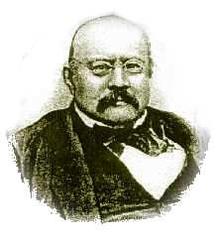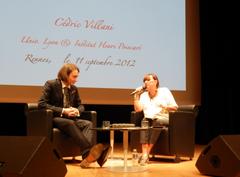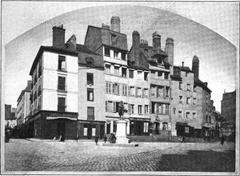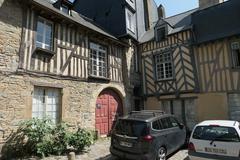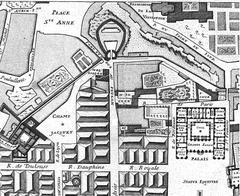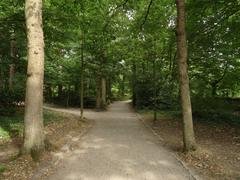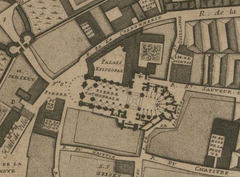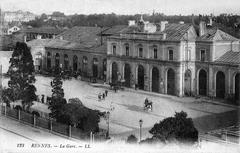Visiting Théâtre De La Parcheminerie, Rennes, France: Tickets, Hours, and Tips
Date: 14/06/2025
Introduction
Théâtre De La Parcheminerie is one of Rennes’ most distinctive cultural landmarks, seamlessly blending medieval heritage with a lively contemporary arts scene. Situated in the city’s historic heart, this former Carmelite convent-turned-parchment workshop stands today as a monument to Rennes’ rich past and dynamic present. With its storied origins, thoughtful restoration, and commitment to accessible, innovative programming, Théâtre De La Parcheminerie is a must-visit destination for history enthusiasts, culture lovers, and curious travelers alike (Tourisme Rennes, La Parcheminerie, Pop Culture Ministry).
This comprehensive guide explores the theater’s fascinating evolution, practical visitor information (opening hours, ticketing, and accessibility), insider travel tips, nearby attractions, and answers to frequently asked questions. Whether you plan to attend a performance or simply want to explore Rennes’ heritage, this article will help you make the most of your visit.
Table of Contents
- History and Transformation
- Modernization and Facilities
- Cultural and Community Role
- Visiting Information
- Travel Tips and Nearby Attractions
- FAQ – Frequently Asked Questions
- Practical Details
- Enhance Your Visit: Stay Connected
- Conclusion
- References
History and Transformation
Medieval Origins
Founded in 1389 as the Couvent des Carmes, Théâtre De La Parcheminerie was originally a Carmelite convent, serving as a spiritual and educational hub in medieval Rennes. The building’s Gothic architecture—with pointed arches, ribbed vaults, and thick stone walls—reflects the era’s turbulent history and religious significance. The convent included a church, cloisters, and living quarters, supporting charitable and educational missions (Tourisme Rennes).
Industrial Era and Decline
During the French Revolution, church properties were nationalized, and the convent was secularized. By the early 19th century, the site had become a center for parchment manufacturing, providing essential materials for Brittany’s growing administrative and legal sectors. The building’s robust structure was well-suited to the laborious parchment-making process, and the name “La Parcheminerie” references this industrial chapter (La Parcheminerie – Histoire).
However, the rise of industrial paper production by the late 19th century led to the decline of parchment workshops. The building subsequently fell into disuse before being recognized for its historical value.
Preservation and Rebirth as a Cultural Venue
In 1975, the former convent and workshop was designated a Monument Historique, safeguarding it against demolition and paving the way for restoration (Pop Culture Ministry). Careful conservation stabilized the structure, preserved medieval features, and allowed for adaptive reuse.
By 1986, a city-led initiative transformed the building into a multidisciplinary cultural center, culminating in the opening of a 200-seat theater in 1989. This adaptive reuse preserved the site’s unique blend of medieval and industrial architecture while meeting the needs of modern audiences (Théâtre de la Parcheminerie – Rennes).
Modernization and Facilities
A major renovation completed in 2019 further improved accessibility, safety, and audience comfort. Funded by the city, the Brittany region, and the French Ministry of Culture, upgrades included:
- Installation of an elevator and ramps for wheelchair access
- Modernized fire safety and emergency systems
- Refurbished seating and backstage areas
- Enhanced climate control and acoustics
Today, the theater features:
- A main hall with 100–200 seats (depending on configuration)
- A flexible workshop/rehearsal area (“la parcelle”)
- A welcoming foyer and outdoor parvis for social gatherings
- Fully accessible facilities for visitors with reduced mobility (Ouest-France, rénovation de la Parcheminerie)
Cultural and Community Role
Théâtre De La Parcheminerie is more than a performance venue: it is a hub for artistic creation, education, and civic engagement. The theater:
- Hosts diverse programming: theater, dance, music, literary events, and art exhibitions
- Partners with local institutions and resident companies (e.g., Compagnie Lumière d’août) (Compagnie Lumière d’août)
- Provides workshops, festivals, and public discussions for all ages
- Fosters community through collaborations with schools, universities, and associations
The theater is also a central venue for citywide festivals such as Festival Mythos and Bars en Trans, and regularly engages the public through debates and creative forums on topics like democracy and ecology (LISAA Rennes).
Visiting Information
Opening Hours and Tickets
- Hours: Typically open Tuesday to Saturday, 2:00 PM–8:00 PM or later on performance nights; hours may vary during festivals and special events. Always check the official website for current schedules.
- Tickets: Purchase online, at the box office, or via authorized resellers. Prices generally range from €5–€15, with discounts for students, seniors, and groups. Some community events and workshops are free or pay-what-you-can (La Parcheminerie tickets and schedule).
- Guided Tours: Available by appointment, often during European Heritage Days.
Accessibility
- Fully equipped for visitors with reduced mobility (elevator, ramps, accessible restrooms)
- Contact the theater for specific accommodation requests
Travel Tips and Nearby Attractions
- Getting There: Located at 23 Rue de la Parcheminerie, 35000 Rennes. Accessible via Sainte-Anne or République metro stations and several bus lines. Public parking nearby (Parking Vilaine, Parking Hoche).
- Best Times to Visit: Late spring to early autumn for cultural festivals and pleasant weather.
- Nearby Attractions: Place Sainte-Anne, medieval city walls, Musée de Bretagne, Parlement de Bretagne, Rennes Cathedral, Marché des Lices (Saturday mornings), and the scenic Vilaine riverbanks.
- Neighborhood: The theater is set on a charming square surrounded by historic streets, cafés, and shops—ideal for pre- or post-show exploration.
FAQ – Frequently Asked Questions
Q: What are the theater’s visiting hours?
A: Hours vary by event, generally Tuesday–Saturday afternoons and evenings. Check the official schedule for details.
Q: How can I buy tickets?
A: Online via the official website, at the box office, or through authorized resellers.
Q: Is the venue accessible to wheelchair users?
A: Yes; the building is modernized for full accessibility.
Q: Are performances only in French?
A: Most are in French; some may be in English or non-verbal. Check individual event details.
Q: Is there parking nearby?
A: Yes; public parking garages (Parking Vilaine, Parking Hoche) are close by, but spaces may be limited.
Q: Are there family-friendly events?
A: Yes; the program includes shows and workshops for children and families.
Practical Details
- Address: 23 Rue de la Parcheminerie, 35000 Rennes, France
- Public Transport: Sainte-Anne or République metro stations; multiple bus lines
- Parking: Public garages and limited street parking
- Facilities: Restrooms, cloakroom, café-bar during events
Enhance Your Visit: Stay Connected
- Stay Updated: Download the Audiala app for real-time event updates, ticketing, and exclusive content.
- Social Media: Follow the theater and Audiala on social platforms for behind-the-scenes content and special offers.
- Further Exploration: Check out related articles on Rennes’ historical sites and cultural venues to enrich your itinerary.
Conclusion
Théâtre De La Parcheminerie is a living testament to Rennes’ enduring heritage and cultural energy. From its medieval convent origins to its role as a contemporary arts center, it invites visitors to experience history, creativity, and community in an evocative setting. Plan your visit today to discover one of Rennes’ most cherished historical and cultural gems.
References and Further Reading
- Tourisme Rennes – History & Heritage
- La Parcheminerie – Histoire
- Pop Culture Ministry – Monument Historique
- Théâtre de la Parcheminerie – Rennes
- Ouest-France – Rénovation de la Parcheminerie
- Compagnie Lumière d’août
- LISAA Rennes Collaboration
- La Parcheminerie Actualités
- Rennes Congrès – La Parcheminerie
- JDS Rennes – La Magie des Loustiks
- Unidivers – Théâtre Parcheminerie
- Agenda Culturel – Théâtre de la Parcheminerie
- Rennes Historical Sites Guide
- Rennes Cultural Events
- Pop Culture Ministry – Cultural Heritage
